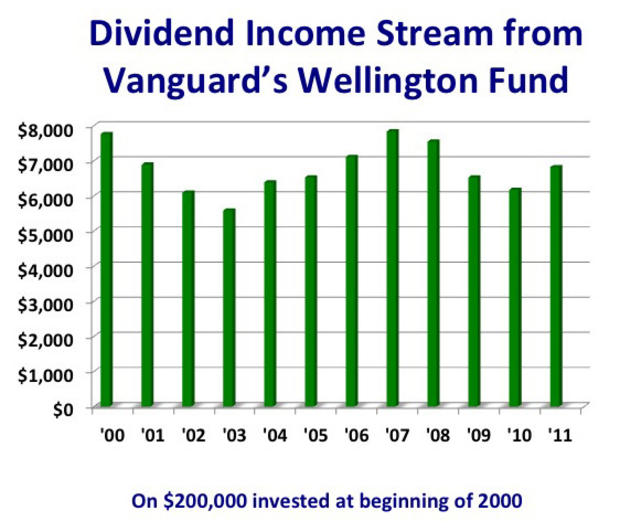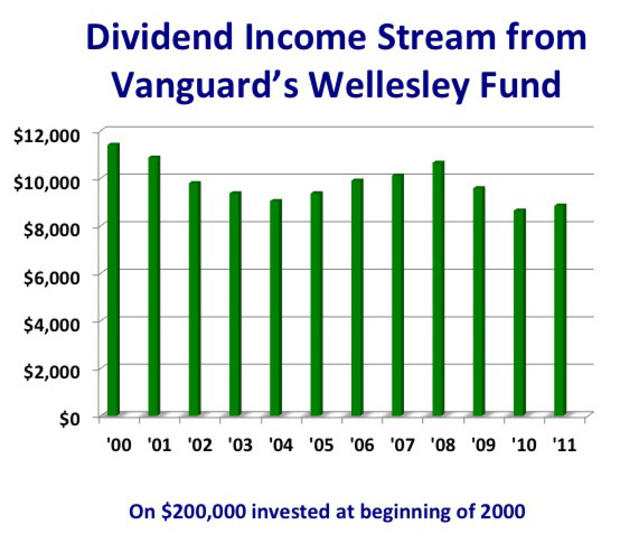Recession-proof your retirement income
(MoneyWatch) As a proponent of planning ahead, I've written previously about three strategies you should learn about that will "recession-proof" your retirement paycheck. One of my earlier posts showed how you might have fared if you had used one of these strategies -- drawing down interest and dividends only from a portfolio balanced between stocks and bonds -- during the "lost" decade of 2000 to 2009. Since a few years had passed, I wanted to update that analysis to include 2010 and 2011.
There are two simple, cost-effective ways for you generate a retirement paycheck from interest and dividends on a balanced portfolio. You can invest in one of the following two funds:
- Vanguard's Wellington fund (VWELX), which is invested about 65 percent in stocks and the rest in bonds and cash investments, or
- Vanguard's Wellesley fund (VWINX), which is invested about 40 percent in stocks and the rest in bonds and cash investments.
IRAs and 401(k): 3 ways to generate lifetime retirement income
Recession-proof your retirement savings
IRA and 401(k): Generate retirement income with just interest and dividends
Of course, there are other low-cost, balanced funds available; most likely your 401(k) plan at work has an investment option that could also could fit the bill.
So let's see how you would have fared if you had invested $200,000 in each of these two funds at the beginning of 2000, and then withdrew just interest and dividends each of the 12 years through the end of 2011.
Vanguard Wellington Fund
By the end of 2011, your initial investment of $200,000 would have grown to $227,266 just on the appreciation of the fund's share price, for a modest total gain of 13.6 percent over the course of 12 years. During your first year -- 2000 -- your interest and dividend payments would have been $7,739, for a yield on investment income of 3.9 percent. Over the next dozen years, you would have received a stream of income with a modest roller-coaster ride, as shown in this graph:
During those 12 years, you also would have received $53,002 in capital gains distributions. You could have used these distributions to boost your retirement savings by the end of 2011 or to fill in the dips in the dividend income stream (or some combination thereof).
Looking forward, if the fund duplicates in 2012 the same dollar amounts of dividends and interest payments it paid in 2011, you'll realize an annual yield of about 3 percent, based on the fund's price at the beginning of 2012.
Vanguard Wellesley Fund
By the end of 2011, your initial investment of $200,000 would have grown to $246,559 just on the appreciation of the fund's share price, for a gain of 23.3 percent over the course of 12 years. During your first year -- 2000 -- your interest and dividend payments would have been $11,398, for a yield on investment income of 5.7 percent. Over the next 12 years, you would have received a fairly steady stream of income, with a less volatile roller-coaster ride than the Wellington fund, as shown in this graph:
During those 12 years, you would have also received $31,559 in capital gains distributions, which you could use to fill in the dips in income, or add to your savings by the end of 2011.
Once again looking forward, if the 2011 dollar amounts of the fund's dividends and interest payments are repeated in 2012, you'll realize an annual yield of about 3.6 percent, based on the fund's price at the beginning of 2012.
When you compare the performance of these two funds, their underlying asset allocations explain the results. The Wellesley fund has a higher allocation to bonds than the Wellington fund. This is the reason this fund earned investors a higher amount of income, and provided reduced volatility in the stream of investment income over the course of the 12-year investment. And because bonds have appreciated due to a significant drop in interest rates since 2000, the Wellesley fund has appreciated more than the Wellington fund. This result isn't likely to be repeated in future years, due to the current low interest rate environment.
More importantly, let's consider the overall results of both funds. If you had invested in either one and lived off the income stream, you would have survived one of the worst periods for investing with a relatively steady stream of income and your retirement savings intact. Many retirement investors fared a lot worse.
During tough times, your investing goal is to survive -- it's unrealistic to expect significant growth in your retirement savings. The very simple investment and drawdown strategy described in this post would have enabled you to survive not one, but two stock market crashes. You also wouldn't have been wiped out, and you wouldn't have needed to make drastic changes in your life.
Finally, you would have kept your principal intact for the day when you might need to increase your retirement paycheck by drawing down principal or buying a low-cost immediate annuity. Not bad results at all.


